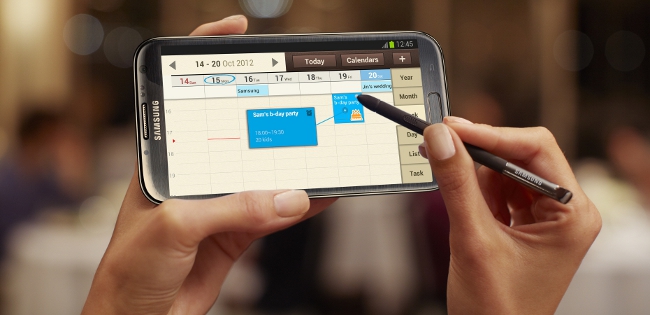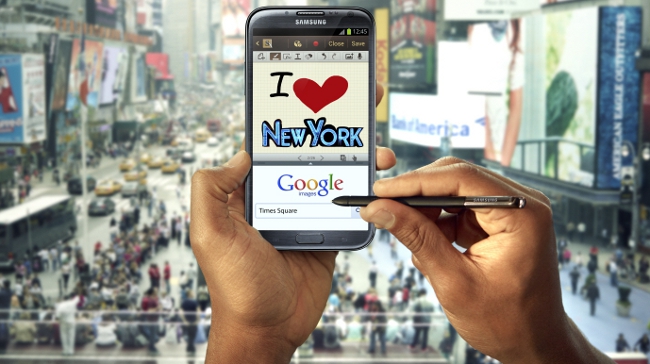The Samsung Galaxy Note II has sold 3m units worldwide since its launch – so what’s the appeal of the updated ‘phablet’, and is it for everyone? We checked it out to answer these questions and more.
Look and feel
My initial thoughts on the Galaxy Note II in my hand is that it’s big. It’s too small for a tablet, but still quite bigger and weightier than your average smartphone.
With its 5.5-inch display, the Note II measures just short of 6 inches long, just over 3 inches wide and less than half an inch thick, weighing 183g – a full 50g heavier than the Galaxy S III.
As it’s a ‘phablet’, the Note II can make calls and to make one-handed dialling more comfortable for users, Samsung has included optional settings to align the keypad to either the left or right-hand of the screen. The same setting can be applied to the full QWERTY keypad and to the phone unlock screen, making it less of a strain for your hands to navigate the new device.
Specifications
Apart from the size, the Note II’s 16:9 Super AMOLED display is practically identical to that of the S III smartphone, as are its cameras: an 8MP rear-facing camera and 1.9MP front-facing camera. However, the Note II can’t record HD video with its front-facing camera.
The device is powered by a 1.6GHz quad-core processor and runs on Android 4.1 Jelly Bean, which, up until last week, was the latest flavour of Android available. What this brings is great, fast and smooth performance, improved accessibility, compatibility with the Google Chrome app, Android Beam (functions of which are enabled by the Note II’s NFC chip) and other such updates.
It also means Google Now, which is built to surface the information you need, when you need it. This information is garnered from various Google-connected sources like your location data, synced calendars, email inbox and search history. Information – such as a weather and traffic update before you leave the house, or details of a flight you are soon to be taking – appears as ‘cards’ under the Google search box.
This is a service that is supposed to learn from users along the way, so if Google Now’s intuition seems a bit off at first, it should – theoretically – get better, so this could be either useful or incorrect depending on how well Google knows you.
New features
Many features of the S III are carried over into the Note II, such as motion controls and the ability to open apps with a swipe from the lock screen, but there are also some unique goodies.
For example, with Quick Glance enabled, the device lights up with notifications, such as messages received or missed calls when the user approaches it. This is made possible by the proximity sensor on the device, so to use it I just waved my hand over that area to see at a glance if I had any messages.
And then, of course, there’s the S Pen, which has been improved with a new shape to offer lots of additional functionality. Using the stylus, users can draw gestures and shortcuts on-screen. The device also senses when the pen is hovering, using this Air View to bring up previews and to control scrolling. Hovering over an icon will even tell you what that button does, much like hovering with your mouse on a desktop will do.

Air View enables users to see full details of an event in their S Planner when hovering over it with the stylus
To ensure users don’t lose their stylus, a function called S Pen Keeper can be enabled. This is meant to alert users if the stylus is not attached when they walk away with their phone. In my experience, this alert can come before you’ve left the vicinity of the S Pen or a few seconds after, so, unless you just jumped out of a taxi, you should be safe enough.
Finally, there’s also multi-tasking. By holding down the ‘back’ key, a menu tab appears on the left of the screen. This can be drawn up while an app is open to launch a second app in a split screen. And, with a pop-up video player, this means the Note II can run three apps on-screen simultaneously – which is fairly impressive.

The Multi-Window feature allows users to open two apps at once
With the Galaxy Note 10.1, multitasking was limited to certain Samsung apps, but the Note II has expanded this to include some Google apps like Chrome, Talk, Gmail and Maps.
Verdict
When I had my first look at the Samsung Galaxy Note II, I was excited by its potential for productivity and multitasking, and the added controls offered by the stylus. However, on starting to use it for myself I did find the written gestures took some getting used to.
The size of the device is also both a good and bad feature. While I have plenty of screen to work with, it is a lot to hold in your hand and my fingers did the strain in parts. (Clearly, I don’t have the hand span of LeBron James.)
Though it takes some practice to get used to, the stylus works really well and the handwriting recognition is spot on 90pc of the time – which for my scrawl was an accomplishment. It’s also a novice friendly device that guides users on how to use it clearly and also carries extensive accessibility settings.
For avid note-takers who are tired of traditional pen and paper, the appeal of this device is obvious. It’s not something I would recommend to a smartphone buyer, but it is something I would recommend to a so-called ‘power user’ as a highly portable second device they can be productive with.